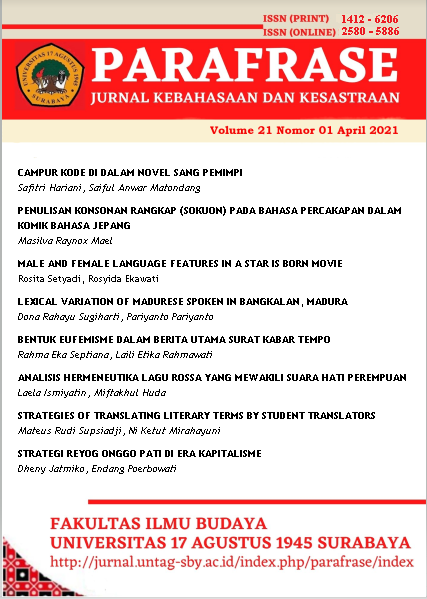MALE AND FEMALE LANGUAGE FEATURES IN A STAR IS BORN MOVIE
DOI:
https://doi.org/10.30996/parafrase.v21i1.4688Abstract
Male and female often have their own language features that are also appear on the use of language in a movie. Lead male and female characters in A Star Is Born have their language features. This study is to discuss the language features in the movie and factors which underlie the occurrence of the language features. This is a qualitative study in which the data of this study are in the form of utterances produced by lead male and female characters in A Star Is Born movie. The data were collected by using a non-participant observation method and analyzed from the perspectives of Lakoff (1973) and Xia (2013) on language features, and Holmes (2013) on social factors. The result of the study shows that there are differences and similarities of lead male and female characters in using language. Both lead male and female characters use adjective feature to express their feeling and utilize swear word to show their emotion. Subsequently, in inviting each other, lead male character utilizes rising intonation, while lead female uses super polite form. Besides, in opening a show, the lead male character uses lexical hedges and fillers, while lead female applies super polite form. Nonetheless, the lead male character is inclined to use adverb and lexical hedges and filler in his utterance, while the lead female does not utilize those features. The occurrences of the language features in the lead characters are influenced by participants, setting, topic, and function.Downloads
References
Dewi, U. (2016). Languange and Gender: Analysis of Margaret Thatcher’s Quotes. Vision, 9, 2086-4213.
Dina, M., &Ariyanti, L. (2017). Gender Feature in Women and Men’s Skin Care Advertisements. Language Horizon, 5, 108-117.
Gu, Lihong. (2013). Language and Gender: Differences and Similarities. International Conference on Advances in Social Science, Humanities, and Management. Atlantis Press.
Haas, Adelaide. (1979). Male and Female Spoken Language Difference: Stereotypes and Evidence. Psychological Bulletin. Vol. 86, No. 3, 615-626
Holmes, J. (2013). An Introduction to Sociolinguistics Fourth Edition. London: Routledge.
Ishikawa, Y. (2015). Gender Differences in Vocabulary Use in Essay Writing by University Students.Procedia, 192, 593-600.
doi: 10.1016/j.sbspro.2015.06.078
Kenneth G. Opina. Verbal Communication Behaviors: How Male and Female University Students Interact in Gendered Talks. International. Journal of Language and Linguistics. Vol. 5, No. 5, 2017, pp. 135-142. doi: 10.11648/j.ijll.20170505.13
Kothari, C. (2004). Research Methodology: Methods and Technique (2nd Ed.). New Delhi: New Age International Publisher.
Lakoff, R. (1973). Language and Women’s Place. New York: Harper & Row Publishers, Inc.
Mazidah, K. U. (2013). Women’s Speech Feature Used by Character Margaret in The Iron Lady Movie. Surabaya: UniversitasNegeri Surabaya.
Mulac, A., Bradac, J., & Gibbons, P. (2006). Empirical support for the gender-as-culture hypothesis. Human Communication Research, 27(1), 121–152. doi:10.1111/j.1468-2958.2001.tb00778.x
Mulac, A. Bradac, J., & Mann, S.K. 1985). Male/female language differences and attributional consequences in chlidren’s television. Human Communication Research. Vol. 11, No. 4, Summer 1985,481-506
Sardabi, N., &Afghari, A. (2015). Gender Differences in the Use Of Intensifiers. Journal of Applied Linguistics and Language Research, 02, 203-213.
Sari, N. (2017). Language Use Between Male and Female Host in HitamPutih Talk Show. Jurnal Linguistik Terapan Pascasarjana, 14, 132-141.
Tepper, Clary A. & Cassidy, Kimberly Wright. (1999). Gender Differences in Emotional Language in Children’s Picture Books. Sex Roles, Vol. 40, Nos. 3/ 4.
Varol, B., & Yilmaz, S. (2010). Similarities and differences between female and male learners: Inside and outside class autonomous language learning activities. Procedia - Social and Behavioral Sciences, 3, 237–244. doi:10.1016/j.sbspro.2010.07.038
Wahyuningsih, S. (2018). Men and Women Differences in Using Language: A Case Study of Students At STAIN Kudus. Edulite, 3, 79-90.
Xia, X. (2013).Gender Differences in Using Language. Academy Publisher, 3, 1485-1489.
doi:10.4304/tpls.3.8.1485-1489
Downloads
Published
How to Cite
Issue
Section
License
Authors publishing in the Journal will be asked to sign a Copyright Assignment Form. In signing the form, it is assumed that authors have obtained permission to use any copyrighted or previously published material. All authors must read and agree to the conditions outlined in the form, and must sign the form or agree that the corresponding author can sign on their behalf. Articles cannot be published until a signed form has been received.It is a condition of publication that authors assign copyright or license the publication rights in their articles, including abstracts, to email jurnalparafrase@untag-sby.ac.id. . This enables us to ensure full copyright protection and to disseminate the article, and of course the Journal to the widest possible readership in print and electronic formats as appropriate.



















